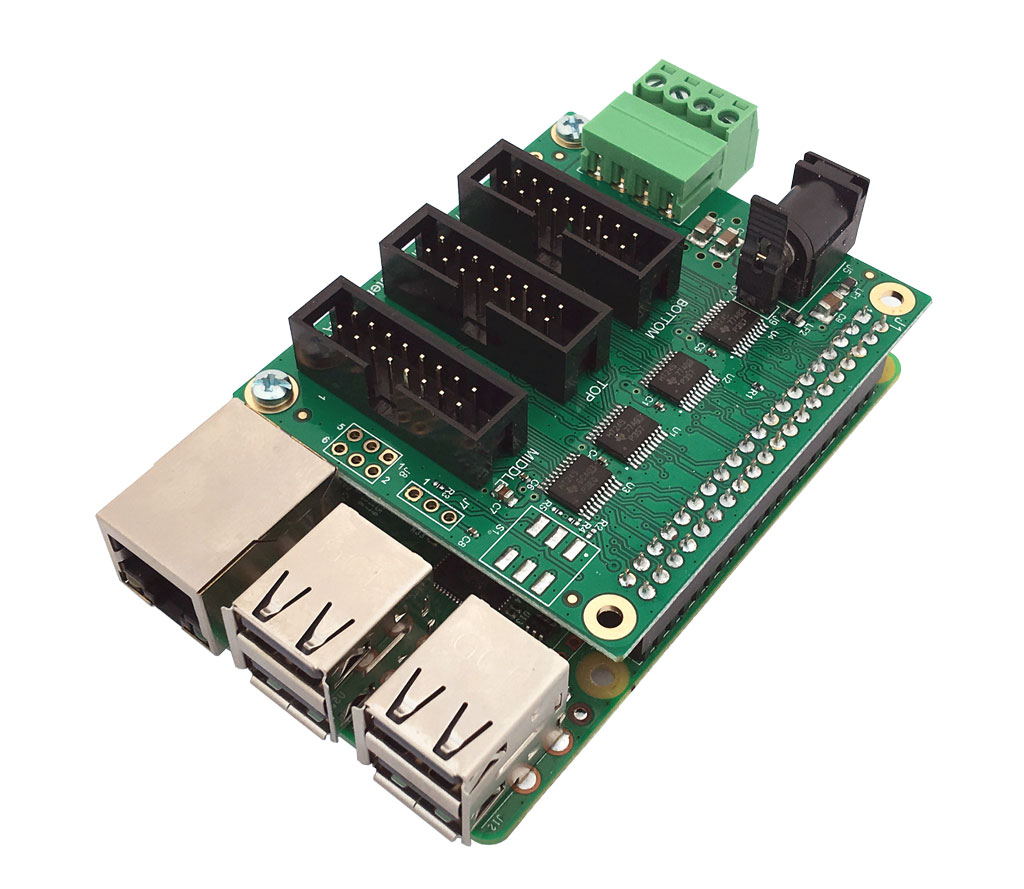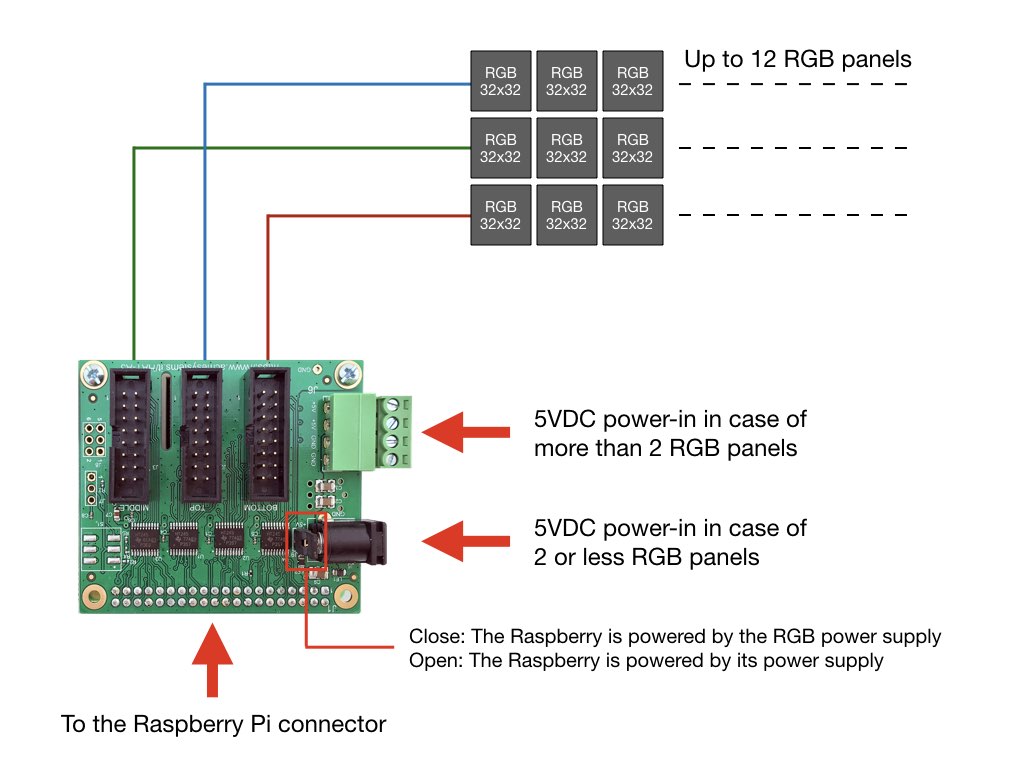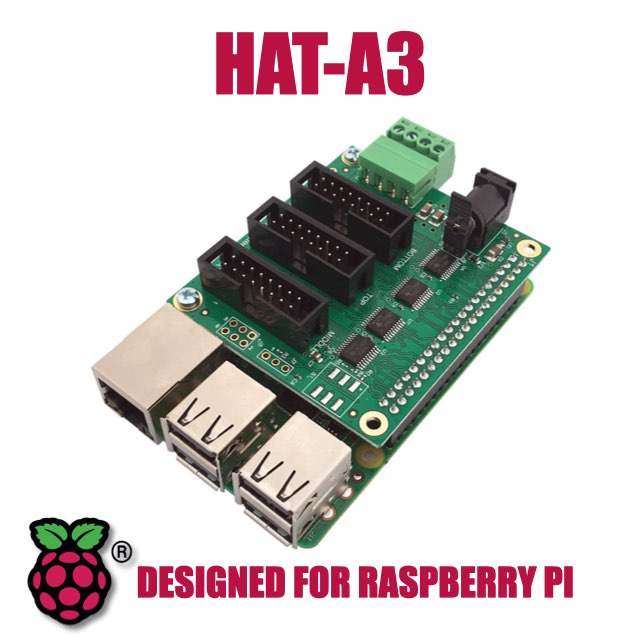HAT-A3 - Led RGB controller for Raspberry Pi

Features
- Fully compatible with the Active-3 board and software designed by Henner Zeller (https://github.com/hzeller/rpi-rgb-led-matrix)
- Supports up to three parallel chains and up to 12 32x32 RGB led modules for each chain
- Active buffering and 3.3V -> 5V level shifting for best reliability.
- Not requires any SMD soldering.

Links
- HAT-A3 schematic
- Original examples by Henner Zeller
- Node-red node for controlling rgb matrix panels
- image-viewer doc
- RGB LED 64x64 module
Demo - Digital signage managed by Telegram
This video shows a simple Telegram bot implemented inside a Raspberry Pi 3 B+ with an Acme HAT-A4 running Node-RED and RedBot. The program sources and the installation details are available on this link:
Install rpi-rgb-led-matrix
The fully documentation to install the Henner Zeller software is available on his GitHub repository from this link:
If you you want to try quickly your HAT-A3 panel these are the Linux commands to install the software (tested on a Raspbian Buster Lite July 2019).
Download the microSD image from this link:
Boot your Raspberry Pi and get the access to the command console. Then type:
sudo apt update
sudo apt -y install git libgraphicsmagick++-dev libwebp-dev libavcodec-dev libavdevice-dev libavformat-dev libswscale-dev initramfs-tools
git clone https://github.com/hzeller/rpi-rgb-led-matrix.git
cd ~/rpi-rgb-led-matrix/utils
make led-image-viewer
make video-viewer
cd ~/rpi-rgb-led-matrix/examples-api-use
make
Remove the snd_bcm2835 module
"If sound is enabled on your Pi, this will not work together with the LED matrix". This problem is explained here:
To remove this module type the following commands:
cat <<EOF | sudo tee /etc/modprobe.d/blacklist-rgb-matrix.conf
blacklist snd_bcm2835
EOF
sudo update-initramfs -u
sudo reboot
Lets try some demos:
This is a list of ready-to-use demos provided with the rpi-rgb-led-matrix
Move inside the examples-api-use directory:
cd ~/rpi-rgb-led-matrix/examples-api-use
and type:
sudo demo
to have the list of ready-to-use demo.
Two parameters are always present:
- led-parallel : Number of HAT-A3 connector used where:
- 1 if is used just the TOP connector
- 2 if are used TOP and MIDDLE connecors
- 3 if are used all the connectors available
- --led-chain : Number of RGB modules connected on a single line. The max number is 12.
If you are using the outdoor P6 RGB module LEDRGB-04 add this other two options:
- led-multiplexing=2
- led-slowdown-gpio=2
Pulse color
Four RGBLED-02 (P6 32x32 indoor module) on the same line wired on TOP connector:
sudo ./demo -D 4 --led-chain=4 --led-parallel=1
Four RGBLED-04 (P6 32x32 outdoor module) on the same line wired on TOP connector:
sudo ./demo -D 4 --led-chain=4 --led-parallel=1 --led-multiplexing=2 --led-slowdown-gpio=2
Show and scroll a ppm image
sudo ./demo -t 10 -D 4 runtext.ppm --led-chain=1 --led-parallel=1
Show images
Move inside the utils directory:
cd ~/rpi-rgb-led-matrix/utils
Show a jpg image
Save a jpg image in this directory and type:
sudo ./led-image-viewer --led-chain=4 --led-parallel=1 image.jpg
Use CTRL-C to exit.
List of options available
./led-image-viewer
Play videos
Move inside the utils directory:
cd ~/rpi-rgb-led-matrix/utils
Show a mp4 video
Save a mp4 video in this directory and type:
sudo ./video-viewer --led-chain=4 --led-parallel=1 video.mp4
Use CTRL-C to exit.
List of options available
./video-viewer
Create a Telegram Bot to play smartphone videos

Botbyexamples is a little set of example to write Telegram Bot in Python.
The example video_on_hat_a3.py shows how to write a Bot that can receive video and play video received from your smartphone.
Related products
demo options
usage: ./demo <options> -D <demo-nr> [optional parameter]
Options:
-D <demo-nr> : Always needs to be set
-t <seconds> : Run for these number of seconds, then exit.
--led-gpio-mapping=<name> : Name of GPIO mapping used. Default "regular"
--led-rows=<rows> : Panel rows. Typically 8, 16, 32 or 64. (Default: 32).
--led-cols=<cols> : Panel columns. Typically 32 or 64. (Default: 32).
--led-chain=<chained> : Number of daisy-chained panels. (Default: 1).
--led-parallel=<parallel> : Parallel chains. range=1..3 (Default: 1).
--led-multiplexing=<0..10> : Mux type: 0=direct; 1=Stripe; 2=Checkered; 3=Spiral; 4=ZStripe; 5=ZnMirrorZStripe; 6=coreman; 7=Kaler2Scan; 8=ZStripeUneven; 9=P10-128x4-Z; 10=QiangLiQ8 (Default: 0)
--led-pixel-mapper : Semicolon-separated list of pixel-mappers to arrange pixels.
Optional params after a colon e.g. "U-mapper;Rotate:90"
Available: "Rotate", "U-mapper". Default: ""
--led-pwm-bits=<1..11> : PWM bits (Default: 11).
--led-brightness=<percent>: Brightness in percent (Default: 100).
--led-scan-mode=<0..1> : 0 = progressive; 1 = interlaced (Default: 0).
--led-row-addr-type=<0..3>: 0 = default; 1 = AB-addressed panels; 2 = direct row select; 3 = ABC-addressed panels (experimental) (Default: 0).
--led-show-refresh : Show refresh rate.
--led-inverse : Switch if your matrix has inverse colors on.
--led-rgb-sequence : Switch if your matrix has led colors swapped (Default: "RGB")
--led-pwm-lsb-nanoseconds : PWM Nanoseconds for LSB (Default: 130)
--led-pwm-dither-bits=<0..2> : Time dithering of lower bits (Default: 0)
--led-no-hardware-pulse : Don't use hardware pin-pulse generation.
--led-panel-type=<name> : Needed to initialize special panels. Supported: 'FM6126A'
--led-slowdown-gpio=<0..4>: Slowdown GPIO. Needed for faster Pis/slower panels (Default: 1).
--led-daemon : Make the process run in the background as daemon.
--led-no-drop-privs : Don't drop privileges from 'root' after initializing the hardware.
Demos, choosen with -D
0 - some rotating square
1 - forward scrolling an image (-m <scroll-ms>)
2 - backward scrolling an image (-m <scroll-ms>)
3 - test image: a square
4 - Pulsing color
5 - Grayscale Block
6 - Abelian sandpile model (-m <time-step-ms>)
7 - Conway's game of life (-m <time-step-ms>)
8 - Langton's ant (-m <time-step-ms>)
9 - Volume bars (-m <time-step-ms>)
10 - Evolution of color (-m <time-step-ms>)
11 - Brightness pulse generator
Example:
./demo -t 10 -D 1 runtext.ppm
led-image_viewer options
usage: ./led-image-viewer [options] <image> [option] [<image> ...]
Options:
-O<streamfile> : Output to stream-file instead of matrix (Don't need to be root).
-C : Center images.
These options affect images FOLLOWING them on the command line,
so it is possible to have different options for each image
-w<seconds> : Regular image: Wait time in seconds before next image is shown (default: 1.5).
-t<seconds> : For animations: stop after this time.
-l<loop-count> : For animations: number of loops through a full cycle.
-D<animation-delay-ms> : For animations: override the delay between frames given in the
gif/stream animation with this value. Use -1 to use default value.
-V<vsync-multiple> : For animation (expert): Only do frame vsync-swaps on multiples of refresh (default: 1)
(Tip: use --led-limit-refresh for stable class='acmetable' rate)
Options affecting display of multiple images:
-f : Forever cycle through the list of files on the command line.
-s : If multiple images are given: shuffle.
General LED matrix options:
--led-gpio-mapping=<name> : Name of GPIO mapping used. Default "regular"
--led-rows=<rows> : Panel rows. Typically 8, 16, 32 or 64. (Default: 32).
--led-cols=<cols> : Panel columns. Typically 32 or 64. (Default: 32).
--led-chain=<chained> : Number of daisy-chained panels. (Default: 1).
--led-parallel=<parallel> : Parallel chains. range=1..3 (Default: 1).
--led-multiplexing=<0..16> : Mux type: 0=direct; 1=Stripe; 2=Checkered; 3=Spiral; 4=ZStripe; 5=ZnMirrorZStripe; 6=coreman; 7=Kaler2Scan; 8=ZStripeUneven; 9=P10-128x4-Z; 10=QiangLiQ8; 11=InversedZStripe; 12=P10Outdoor1R1G1-1; 13=P10Outdoor1R1G1-2; 14=P10Outdoor1R1G1-3; 15=P10CoremanMapper; 16=P8Outdoor1R1G1 (Default: 0)
--led-pixel-mapper : Semicolon-separated list of pixel-mappers to arrange pixels.
Optional params after a colon e.g. "U-mapper;Rotate:90"
Available: "Mirror", "Rotate", "U-mapper", "V-mapper". Default: ""
--led-pwm-bits=<1..11> : PWM bits (Default: 11).
--led-brightness=<percent>: Brightness in percent (Default: 100).
--led-scan-mode=<0..1> : 0 = progressive; 1 = interlaced (Default: 0).
--led-row-addr-type=<0..4>: 0 = default; 1 = AB-addressed panels; 2 = direct row select; 3 = ABC-addressed panels; 4 = ABC Shift + DE direct (Default: 0).
--led-show-refresh : Show refresh rate.
--led-limit-refresh=<Hz> : Limit refresh rate to this frequency in Hz. Useful to keep a
constant refresh rate on loaded system. 0=no limit. Default: 0
--led-inverse : Switch if your matrix has inverse colors on.
--led-rgb-sequence : Switch if your matrix has led colors swapped (Default: "RGB")
--led-pwm-lsb-nanoseconds : PWM Nanoseconds for LSB (Default: 130)
--led-pwm-dither-bits=<0..2> : Time dithering of lower bits (Default: 0)
--led-no-hardware-pulse : Don't use hardware pin-pulse generation.
--led-panel-type=<name> : Needed to initialize special panels. Supported: 'FM6126A', 'FM6127'
--led-slowdown-gpio=<0..4>: Slowdown GPIO. Needed for faster Pis/slower panels (Default: 1).
--led-daemon : Make the process run in the background as daemon.
--led-no-drop-privs : Don't drop privileges from 'root' after initializing the hardware.
Switch time between files: -w for static images; -t/-l for animations
Animated gifs: If both -l and -t are given, whatever finishes first determines duration.
The -w, -t and -l options apply to the following images until a new instance of one of these options is seen.
So you can choose different durations for different images.
video-viewer options
usage: ./video-viewer [options] <video>
Options:
-O<streamfile> : Output to stream-file instead of matrix (don't need to be root).
-s <count> : Skip these number of frames in the beginning.
-c <count> : Only show this number of frames (excluding skipped frames).
-v : verbose.
-f : Loop forever.
General LED matrix options:
--led-gpio-mapping=<name> : Name of GPIO mapping used. Default "regular"
--led-rows=<rows> : Panel rows. Typically 8, 16, 32 or 64. (Default: 32).
--led-cols=<cols> : Panel columns. Typically 32 or 64. (Default: 32).
--led-chain=<chained> : Number of daisy-chained panels. (Default: 1).
--led-parallel=<parallel> : Parallel chains. range=1..3 (Default: 1).
--led-multiplexing=<0..10> : Mux type: 0=direct; 1=Stripe; 2=Checkered; 3=Spiral; 4=ZStripe; 5=ZnMirrorZStripe; 6=coreman; 7=Kaler2Scan; 8=ZStripeUneven; 9=P10-128x4-Z; 10=QiangLiQ8 (Default: 0)
--led-pixel-mapper : Semicolon-separated list of pixel-mappers to arrange pixels.
Optional params after a colon e.g. "U-mapper;Rotate:90"
Available: "Rotate", "U-mapper". Default: ""
--led-pwm-bits=<1..11> : PWM bits (Default: 11).
--led-brightness=<percent>: Brightness in percent (Default: 100).
--led-scan-mode=<0..1> : 0 = progressive; 1 = interlaced (Default: 0).
--led-row-addr-type=<0..3>: 0 = default; 1 = AB-addressed panels; 2 = direct row select; 3 = ABC-addressed panels (experimental) (Default: 0).
--led-show-refresh : Show refresh rate.
--led-inverse : Switch if your matrix has inverse colors on.
--led-rgb-sequence : Switch if your matrix has led colors swapped (Default: "RGB")
--led-pwm-lsb-nanoseconds : PWM Nanoseconds for LSB (Default: 130)
--led-pwm-dither-bits=<0..2> : Time dithering of lower bits (Default: 0)
--led-no-hardware-pulse : Don't use hardware pin-pulse generation.
--led-panel-type=<name> : Needed to initialize special panels. Supported: 'FM6126A'
--led-slowdown-gpio=<0..4>: Slowdown GPIO. Needed for faster Pis/slower panels (Default: 1).
--led-daemon : Make the process run in the background as daemon.
--led-no-drop-privs : Don't drop privileges from 'root' after initializing the hardware.

Systems designer, webmaster of www.acmesystems.it and founder of Acme Systems srl
Personal email: tanzilli@acmesystems.it
Web pages: https://www.acmesystems.it --- https://www.acmestudio.it
Github repositories: https://github.com/tanzilli --- https://github.com/acmesystems
Telegram group dedicated to the Acme Systems boards: https://t.me/acmesystemssrl






